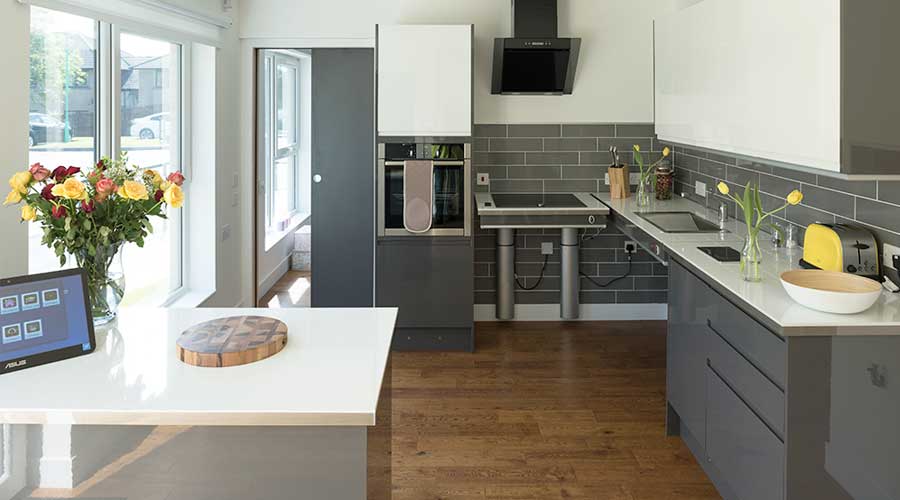
How to improve residents’ lives and save staff resources in the bathroom
The bathroom can be a dangerous place for the elderly and for people with disabilities. Slick surfaces, hard fixtures and tight quarters can make every day routines challenging for people with limited mobility.
For the owners and operators of America’s assisted living facilities, bathrooms not only present potential dangers to residents – they’re also where many workplace injuries occur. When workers help residents in and out of the shower or onto and off the toilet, the lifting, turning and positioning often puts significant strain on the caregivers’ bodies.
Even without the risk factor, the need for bathroom assistance comes at the cost of the residents’ dignity and self-esteem and the caregivers’ limited time. The former is one of the main reasons seniors would prefer not to end up in a home in the first place, and the latter puts additional pressure on an industry suffering through a work shortage.
Safety features can backfire
Often, the very features that are put in assisted living bathrooms to increase safety end up creating additional challenges for both residents and staff.
Many bathroom protection solutions cannot be moved once it is installed and may become a hindrance. For instance, a support bar might actually make it more difficult to transfer a patient to and from the toilet, which can be dangerous for both the patient and the care worker. However, if a support bar could be moved both horizontally and vertically, many residents would be able to handle their toilet visits alone. This is both a boost to their independence and a way to free up worker resources for other tasks and residents.
Most assisted living facilities offer residents their own private bathrooms. But often an elderly person’s mobility will change during the course of the day. They may wake up with plenty of energy and easily be able to handle their own bathroom visits before their energy starts to dwindle. A male resident, for example, may start the day able to urinate while standing with little or no need for a support bar. By evening, however, he may need a wheelchair to get around, and the support bar that was helpful hours earlier can now create a barrier to getting on the toilet and he will need a worker’s help.
Over time, the resources that are used to accommodate these changes in needs add up, and when considering that the average stay in an assisted living home is 22 months, facilities have to frequently make semi-permanent adjustments to accommodate each new resident.
For example, if you have a typical bathroom in an assisted living facility, which could have one or two users per year whose needs and health often changes, it may be necessary to make ten adjustments to the bathroom safety solutions so that it offers the correct assistance. This might not sound excessive, but if a facility has 60 bathrooms, then over a period of 15 years, this equipment could be adjusted up to 9,000 times.
Adjustable solutions save resources
If the bathroom solutions were more flexible, fully customizable, and easier to operate then the total number of adjustments could be higher, allowing for greater customization to each resident’s specific needs. All the while, the time and effort to make those adjustments would be much lower.
For example, solutions are available that allow workers to easily change the height or placement of support bars and shower seats. These mobility aids can even be completely removed again and moved to the bathroom of another resident who needs them. All of this can be done without the use of tools.
In other cases, the residents themselves can simply make the adjustments they need to use the bathroom throughout the day. For instance, with the push of a button, a standing sink can lowered to the height of a wheelchair user. A user can fold up support arms in the mornings when mobility is high and then put them back into place as energy levels wane in the evening hours.
This ability to maintain independence in the bathroom is an obvious benefit for the residents themselves, yet it’s also able to ensure that facilities can use their limited resources more efficiently.
Cutting down on the need for care workers in the bathroom can also help assisted living facilities make better use of their limited resources. An estimated 64 percent of assisted living residents need help bathing and 40 percent need assistance using the toilet. Even bringing those numbers down a little would free up time for staff to focus on other residents and tasks.
Some facilities, such as hospitals and skilled nursing centers, have a policy that two care workers must assist the patient with a bathroom visit. When considering the nationwide care worker shortage, if the residents were able to safely make their own adjustments to the safety equipment and use it, the staff would be in the position where they could help more people without any resident suffering.
ADA compliant consultancy
Keeping track of requirements for ADA compliant bathroom design can be challenging in a project with many other aspects. By involving Pressalit early in your process, we can help ensure ADA compliance when it comes to designing the optimal, accessible bathroom and taking all necessary precautions into consideration.
Related articles
You can find more guidance, information and inspiration in the articles listed below.














